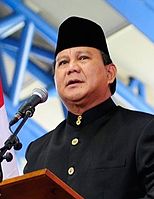Indonesian presidential election, 2014
|
|
|||||||||||||||||||
|---|---|---|---|---|---|---|---|---|---|---|---|---|---|---|---|---|---|---|---|
|
|||||||||||||||||||
| Turnout | 69.58% | ||||||||||||||||||
|
|||||||||||||||||||

Results of the election showing the candidates with the largest share of votes in each of the 33 provinces of Indonesia. Joko Widodo: red; Prabowo Subianto: crimson.
|
|||||||||||||||||||
|
|||||||||||||||||||
Susilo Bambang Yudhoyono
Demokrat
The 3rd Indonesian presidential election was held on 9 July 2014 and matched former general Prabowo Subianto against the governor of Jakarta, Joko Widodo; incumbent president Susilo Bambang Yudhoyono was constitutionally barred from seeking a third term in office. On 22 July the General Elections Commission announced Joko Widodo's victory. He and his vice-president, Jusuf Kalla, were sworn-in on 20 October 2014, for a 5-year term.
According to the 2008 election law, only parties or coalitions controlling 20% of DPR seats or winning 25% of the popular votes in the 2014 parliamentary elections are eligible to nominate a candidate. This law was challenged in the Constitutional Court, but in late January 2014 the Court ruled that the requirement would stand for this election. No party exceeded the threshold in the 2014 legislative elections, therefore two coalitions were formed.
Arrangements for the conduct of elections in Indonesia are carried out under the supervision of the General Elections Commission (Komisi Pemilihan Umum, or KPU).
The presidential elections in 2014 will be carried out in accordance with the Law, (Undang-undang, or UU) No 42 of 2008 about the election of a president and vice-president.
Arrangements for nominations
An important requirement, set out in Law No 42 of 2008 (Clause 9), is that nominations of candidates for the presidential election may only be made by a party (or coalition of parties) which has at least 20% of the seats in the national parliament (the DPR, or the Dewan Perwakilan Rakyat) or which received 25% of national votes in the previous national legislative election for the DPR. In practice, berita terkini these conditions set a rather high bar for nomination. The likelihood is that only candidates supported by one of the major parties, perhaps with some support from several of the minor parties, will be able to meet the conditions for nomination. Among other things, the effect of this requirement is likely to be a strict limit on the number of candidates who will be able to stand for the presidency.
...
Wikipedia


